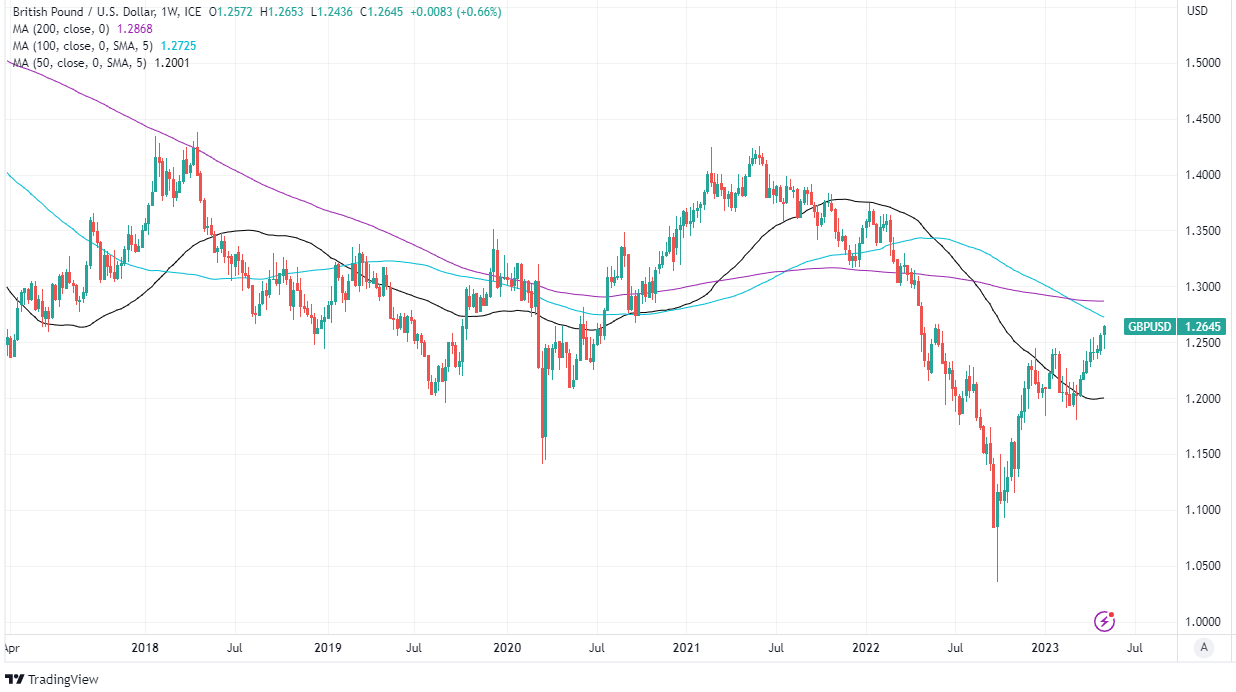Bank of England Decision is Key Risk for Sterling this Week
- Written by: James Skinner
-

Image © Adobe Stock
Pound Sterling reached its highest levels since April last year in the final session of the week as an earlier rally approached its ninth week but risks stemming from next Thursday's Bank of England (BoE) interest rate decision are potentially all on the downside.
The Pound to Dollar exchange rate climbed above 1.26 on Friday while rising in relation to most others in the G20 basket with only a handful of exceptions such as the Norwegian Krone, Swedish Krona, Mexican Peso, Russian Rouble, Canadian Dollar and Australian Dollar.
Gains built amid a rally for risky assets led by shares of troubled U.S. banks, which came hard on the heels of another blockbuster non-farm payrolls report and amid speculation that an agreement to temporarily raise the U.S. debt ceiling is near.
But Friday's price action leaves Sterling at risk of losses next week when the Bank of England is set to announce updated forecasts for the UK economy alongside what economists and financial markets expect to be another increase in Bank Rate.
"UK activity data has surprised to the upside in recent weeks and our economists now expect a peak Bank rate of 5%," says Sharon Bell, a senior strategist in the European Portfolio Strategy team at Goldman Sachs, in a Friday research briefing
Above: Pound to Dollar rate at daily intervals with selected moving averages. Click image for closer inspection.
"The better growth and higher rate expectations have pushed up sterling which ordinarily would boost UK domestic stocks, but their reaction has been contained this time as EPS [earnings per share] estimates have remained relatively weak," she adds.
The BoE raised Bank Rate to 4.25% in late March while hinging future policy decisions on inflation and other economic outcomes in the months ahead but the rub for the BoE and economy is that much of the recent data coming from the UK has led financial markets to expect even further increases in interest rates.
Most notably, inflation fell only as far as 10.1% in March when it had been expected to drop back into the single digits while retail sales, once adjusted for inflation, have posted their first quarterly increase since the summer of 2021 and the overall economy has appeared to rebound in the early months of the new year.
GBP/USD Forecasts Q2 2023Period: Q2 2023 Onwards |
When combined with the growth of wages and salaries that has continued to run in the high single digits, the BoE might feel compelled to raise Bank Rate further on Thursday and will have little choice other than to upgrade its forecasts for the economy.
"If there was ever any doubt that the MPC would raise Bank Rate at next week's meeting, this week's UK data quickly dispelled it," writes Andrew Goodwin, chief UK economist at Oxford Economics, in a Friday research briefing.
"Further evidence of strengthening activity – particularly in consumer-facing sectors – and inflation persistence mean the MPC's criteria for raising interest rates have been unambiguously met," he adds.
Source: Oxford Economics.
Goodwin and colleagues cite S&P Global's upward revision this week to estimates of activity in the manufacturing and services sectors in April as a likely additional catalyst for another increase in Bank Rate next week but warned that the BoE could follow in the footsteps of the Federal Reserve by reducing its "tightening bias."
That would undermine market-implied expectations for Bank Rate to rise as far as 5% in the months ahead while counting as a bearish outcome for Sterling but the Pound could also be hampered next week if if the BoE shows an inclination to indulge market expectations because of the risks it would store up for the economy.
The economy has shown resilience in recent months but that doesn't mean it hasn't slowed or that the BoE's infamous forecast of a five-quarter recession couldn't yet be realised as the effects of the already very substantial increase in Bank Rate works its way into the residential mortgage market over the course of this year.
Bank Rate was lifted from 0.1% to 4.25% between December 2021 and March this year, which has doubled the cost of owning a home over the life of a 25-year mortgage for those who fixed borrowing costs at any point in the recent years, and there is no longer any meaningful form of Mortgage Interest Relief for ordinary households.
"An improving UK growth backdrop has provided some cushion for GBP, but it has started to deviate from some of our short-term models," writes Mark McCormick, global head of FX strategy at TD Securities, in a Friday research briefing.
Above: Pound to Dollar rate at weekly intervals with selected moving averages. Click for closer inspection.
GBP/USD Forecasts Q2 2023Period: Q2 2023 Onwards |













